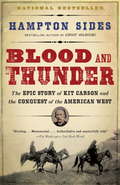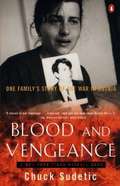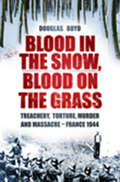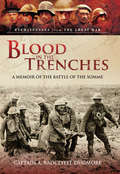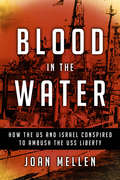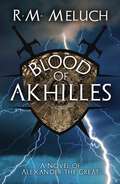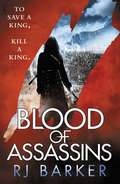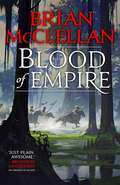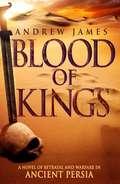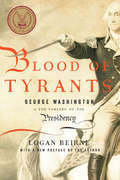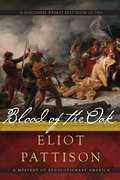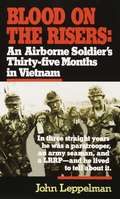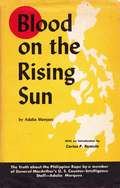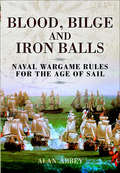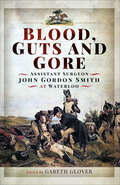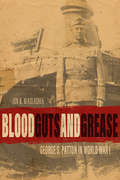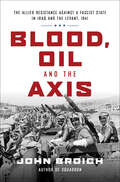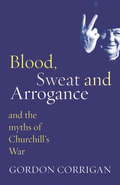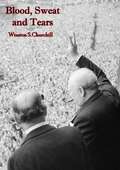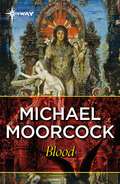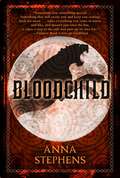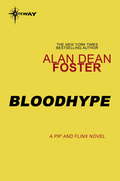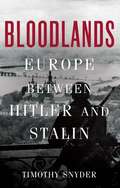- Table View
- List View
Blood and Thunder
by Hampton SidesNATIONAL BESTSELLER • From the author of Ghost Soldiers comes an eye-opening history of the American conquest of the West—"a story full of authority and color, truth and prophecy" (The New York Times Book Review).In the summer of 1846, the Army of the West marched through Santa Fe, en route to invade and occupy the Western territories claimed by Mexico. Fueled by the new ideology of &“Manifest Destiny,&” this land grab would lead to a decades-long battle between the United States and the Navajos, the fiercely resistant rulers of a huge swath of mountainous desert wilderness. At the center of this sweeping tale is Kit Carson, the trapper, scout, and soldier whose adventures made him a legend. Sides shows us how this illiterate mountain man understood and respected the Western tribes better than any other American, yet willingly followed orders that would ultimately devastate the Navajo nation. Rich in detail and spanning more than three decades, this is an essential addition to our understanding of how the West was really won.
Blood and Vengeance
by Chuck SudeticTaking its place on the short list of essential books about the Bosnian struggle, Blood and Vengeance succeeds in putting a human face-on the conflict, rendering its devastation comprehensible to Western readers. Perhaps the most notorious and disputed outrage of the war was the massacre of as many as 8,000 Muslims in Srebrenica. Although previously designated a safe area by the United Nations Security Council, Srebrenica was overrun by General Ratko Mladic's Bosnian Serb forces while U.N. peacekeeping troops stood by impotently.<P>With novelistic eloquence and journalistic acumen, Sudetic follows several generations of the Celiks, the Muslim family he is related to by marriage, which met their tragic destiny at Srebrenica. His indelible portrait of these inhabitants of a remote mountaintop village outside of Srebrenica not only illumines the historical context of the tragedy but, more important, reveals the human impact of the horror. Blood and Vengeance contains the sweep and power of a panoramic historical painting, yet possesses the heartbreaking intimacy of a family snapshot.
Blood in the Snow, Blood on the Grass: Treachery, Torture, Murder and Massacre - France 1944
by Douglas BoydNearing D-Day, Allied intelligence used thousands of young men hiding in France's forests and hill country to avoid compulsory labour service in Germany as bait to draw German forces away from the Normandy beaches. There are two principles of guerilla warfare: never to concentrate your forces or rish a pitched battle. But with RAF airdrops of pistols and Sten guns came British, American and French liaison officers who concentrated these untrained civilians in remote areas of France. They thought Allied airborne foreces would land and help them drive the Germans out of their country, but instead were hunted down by collaborationist French paramilitaries, Wehrmacht and Waffen-SS troops. They died in the snows of winter through high midsummer. Those taken prisoner were raped, tortured and shot or deported to death camps in Germany. Many of their killers were themselves murdered after the liberation, when thousands of French women were also publicly humiliated as sexual traitors.
Blood in the Trenches: A Memoir of the Battle of the Somme (Eyewitnesses from The Great War Series)
by Captain A. Dugmore<p>Written by Captain A. Radclyffe Dugmore of the King's Own Light Infantry, this personal memoir provides an excellent account of the Great War up to the Battle of the Somme. A wide ranging and perceptive relation of events, Radclyffe Dugmore's pedigree as a professional writer shines through. In 1914, Radclyffe Dugmore travelled to Belgium as a civilian observer where he was wounded before spending a brief time in German captivity. These experiences gained Radclyffe Dugmore a highly unusual viewpoint for the opening battles of the war, that of a civilian, and later as a participant on the front lines of the Somme.Originally published under the title When The Somme Ran Red in 1918, Radclyffe Dugmore's memoir has sadly been long out of print. Yet what the author modestly described as 'Being a very egotistical account of my own personal experiences and observations from the early days of the war in Belgium to the Great Battle of the Somme in July, 1916' proves to be anything but that, consisting of a fascinating and rare account, sympathetically dedicated to the memory of the officers and men of the King's Own Yorkshire Light Infantry who fell in the Battle of the Somme.<p> <p>This new re-print of Radclyffe Dugmore's classic volume is a worthy addition to the primary source literature of the Great War, and casts new light on the experiences of the brave men who saw the terror of the Battle of the Somme first hand.<p>
Blood in the Water: How the US and Israel Conspired to Ambush the USS Liberty
by Joan MellenPresents evidence suggesting collusion between US and Israeli intelligence in the attack on a US naval surveillance vessel during the Six-Day War and the more than fifty-year long cover-up.On June 8, 1967, the USS Liberty, an unarmed intelligence ship reporting to the Joint Chiefs of Staff under the auspices of the National Security Agency, was positioned in international waters off the coast of Egypt when it was attacked with deadly violence by unmarked jet planes firing rockets and machine guns and throwing napalm onto its deck. This ambush was followed by a torpedo strike that blew a forty-foot hole in the starboard side of the ship. Lacking the capacity to defend themselves, thirty-four sailors were killed and 174 wounded, many for life. By the end of the day, Israel had confessed to having been the aggressor, simultaneously arguing that the attack had been an "accident" and a "mistake." The facts said otherwise. So intense and sustained was the attack - it lasted for nearly an hour and a half - so specific was the aiming for the antennae and satellite dish on deck, that it was scarcely credible that Israel's aggression was not deliberate; such was the view of Marshall Carter, the director of the National Security Agency, his deputy director Louis Tordella, and Richard Helms, the Director of Central Intelligence. Based on interviews with more than forty survivors, knowledgeable political insiders, and Soviet archives of the period, investigative writer Joan Mellen presents evidence suggesting complicity between US and Israeli intelligence in the attack on Liberty and the more than fifty-year long cover-up. What were the underlying motives? Was this a false flag operation conducted in the midst of the Six-Day War? Was it conceivable that Israel would have initiated such an operation without a green light from the United States? For the sake of justice, truth and the murdered and surviving sailors, this is a story demanding to be told.
Blood of Akhilles: A Novel of Alexander the Great
by R. M. MeluchKing Philip lies dead in the theatre, struck down like a sacrificial bull on his day of triumph in front of all the subject nations of Hellas. Twenty-year-old Alexander, son of Philip, must seize his father&’s throne and, harder still, he must hold it against his many rivals, who are Philip&’s veteran generals and noblemen, a royal cousin who was once crowned king in his infancy, and the secret conspirators who moved the assassin&’s hand, even as all the conquered cities of Hellas rise from under Philip&’s dead heel to reclaim their independence from the despised Makedones. The task is overwhelming, but Alexander has complete faith in his own destiny and he quite literally changes the face of Hellas. Born in the Dog Star&’s heat, on the sixth of the month of Loios, the very day that a wonder of the world, the great temple of Artemis at Ephesos, burned to the ground, Alexander was destined for immortality. When such events collide, of gods and kings, such things are never coincidence. Alexander is blood of Akhilles.
Blood of Assassins (The Wounded Kingdom #2)
by Rj BarkerThe epic sequel to RJ Barker's fantasy debut Age of Assassins, set in a world ravaged by magic, featuring a cast of assassins, knights, and ambitious noblemen.In a desperate bid to escape the bounty on his head, assassin Girton Club-Foot has returned to Maniyadoc, but the kingdom he knew no longer exists.Three kings battle for supremacy in a land ravaged by war-and one of them is his old friend Rufra. With threats inside and outside the war encampment, Girton races to find the traitor behind an assassination plot. But his magic can no longer be contained and Girton may not be able to save even himself. It's assassin versus assassin for the life of a king.The Wounded KingdomAge of AssassinsBlood of Assassins
Blood of Empire: Book Three Of Gods Of Blood And Powder (Gods of Blood and Powder #3)
by Brian McClellanAs the final battle approaches a sellsword, a spy, and a general must find unlikely and dangerous allies in order to turn the tides of war in the last book of Brian McClellan's epic fantasy trilogy of magic and gunpowder.The Dynize have unlocked the Landfall Godstone, and Michel Bravis is tasked with returning to Greenfire Depths to do whatever he can to prevent them from using its power; from sewing dissension among the enemy ranks to rallying the Palo population. Ben Styke's invasion of Dynize is curtailed when a storm scatters his fleet. Coming ashore with just twenty lancers, he is forced to rely on brains rather than brawn - gaining new allies in a strange land on the cusp of its own internal violence. Bereft of her sorcery and physically and emotionally broken, Lady Vlora Flint now marches on Landfall at the head of an Adran army seeking vengeance against those who have conspired against her. While allied politicians seek to undo her from within, she faces insurmountable odds and Dynize's greatest general.Continue the epic fantasy series by the author whose debut novel Brandon Sanderson called "just plain awesome!"Gods of Blood and PowderSins of EmpireWrath of EmpireBlood of EmpireFor more from Brian McClellan, check out:Powder MagePromise of BloodThe Crimson CampaignThe Autumn Republic
Blood of Kings
by Andrew JamesPraise for Blood of Kings:'Extremely compelling..... an almost Game of Thrones feel at times. The novel is certainly a page-turner...I look forward to reading a continuation' Ancient Warfare Magazine'This is a brilliantly written and scrupulously researched historical novel that uniquely captures the atmosphere surrounding the rise to power of Darius, the greatest king of Ancient Persia. His story is interwoven with parallel events in Egypt and Greece, making this novel of absorbing interest to anybody with an interest in the ancient world' Dr John Curtis, OBE, FBA, formerly Keeper of the Department of Middle East, the British MuseumIt is 530 BC and Cyrus the Great has carved out the largest Empire the world had ever seen, making Persia the undisputed superpower of the ancient world. But there is treachery afoot, and Cyrus's life is in danger. In a fast paced tale of love, war, betrayal and revenge, Blood of Kings sweeps the reader up on an epic journey from the mud brick cities of Ancient Persia to the burning heart of Pharaoh's Egypt. Packed full of dramatic and authentic battle scenes, it recreates the sweat, blood and fear of ancient warfare, as Persia smashes Egypt's army and brings the reign of the Pharaohs to a violent end. But it is also a book that will delight Herodotus fans, bringing the ancient Greek historian's characters to life like never before, as it follows the doomed 'lost army of Cambyses' into the Libyan Desert, marching towards a fate that would baffle archaeologists for millennia to come. 'You must read Blood of Kings. . . a masterpiece of historical fiction' Dr Bryan Wood, Author'Vivid...original and fascinating' F. Bailey, Scriptwriter for BBC's 'Peak Practice' 'Andrew James has captured the very spirit of the Ancient Achaemenids . . . he literally takes the reader back in time to the Persians of old. I would highly recommend this historical novel . . .' Dr Kaveh Farrokh, Lecturer and Reader of History at the University of British Columbia Continuing Studies Division
Blood of Tyrants
by Logan BeirneBlood of Tyrants reveals the surprising details of our Founding Fathers' approach to government and this history's impact on today. Delving into the forgotten-and often lurid-facts of the Revolutionary War, Logan Beirne focuses on the nation's first commander in chief, George Washington, as he shaped the very meaning of the United States Constitution in the heat of battle.Key episodes illustrate how the Founders dealt with thorny wartime issues: Who decides war strategy? When should we use military tribunals over civilian trials? Should we inflict harsh treatment on enemy captives if it means saving American lives? How do we protect citizens' rights when the nation is struggling to defend itself? Beirne finds evidence in previously-unexplored documents such as General Washington's letters debating torture, an eyewitness account of the military tribunal that executed a British prisoner, Founders' letters warning against government debt, and communications pointing to a power struggle between Washington and the Continental Congress.Vivid stories from the Revolution frame Washington's pivotal role in the drafting of the Constitution. The Founders saw the first American commander in chief as the template for all future presidents: a leader who would fiercely defend Americans' rights and liberties against all forms of aggression.Blood of Tyrants pulls the reader directly into the scenes, filling the void in our understanding of the presidency and our ingenious Founders' pragmatic approach to issues we still face today.
Blood of the Oak: A Mystery (The Mystery of Colonial America Series #4)
by Eliot PattisonA Publishers Weekly Best Book of 2016 The year is 1765, at the beginning of the Stamp Tax dissent, the first organized resistance to English rule. Duncan McCallum is drawn into the mystery of aseries of murders and kidnappings that are strangely connected to the theft of an Iroquois artifact. In following the trail, he uncovers a network of secret runners supporting the nascent €œcommittees of correspondence, engaged in the first organized political dissent across colonial borders. When he is captured and thrown into slavery with the kidnapped runners, Duncan encounters a powerful conspiracy of highly placed English aristocrats who are bent on crushing all dissent. Inspired by an aged Native American slave and new African friends, Duncan decides not just to escape but to turn their own intrigue against the London lords.The fourth entry in the Bone Rattler series moves ever closer to the beginning of theAmerican Revolution. Included in the novels cast of characters are figures who willhave their destinies to fulfill in the next decade: Benjamin Franklin, Samuel Adams,the early Pennsylvania rebel James Smith, and Dr. Benjamin Rush. Blood of the Oaktakes a fresh view on the birth of the new American nation, suggesting that the €œfreedomthat became the centerpiece of the Revolution was uniquely American, rising notonly from unprecedented political discourse but also from the extraordinary bond withthe natural world experienced by frontier settlers and native tribes.
Blood on the Risers: An Airborne Soldier's Thirty-five Months in Vietnam
by John LeppelmanFrom Dak To to the Tet Offensive, John Leppelman saw it all. In three tours of duty, he made combat jumps, spent months of fruitless effort looking for the enemy, watched as his budies died because of lousy leadership and lousy weapons. He saw the war as few others did, and lives to tell about the valor and sacrifice that outlived the dead.From the Paperback edition.
Blood on the Rising Sun: A Factual Story of the Japanese Invasion of the Philippines
by Adalia MarquezThe Truth about the Philippine Rape by a member of General MacArthur’s U.S. Counter-Intelligence Staff—Adalia MarquezBLOOD ON THE RISING SUN is a true story of life in Manila under Japanese occupation and, later, during the American liberation. There have been many tales told about guerrilla activities and underground operations in the Philippines but in almost all of them the chief protagonists are Americans. BLOOD ON THE RISING SUN is the story of the fights against the Japanese waged by a Filipino woman, her husband, and their friends and presents an aspect of the Philippine resistance that has never yet been told.Adalia’s account of life in the prison hellhole of Fort Santiago describes the terrible privations and tortures the inmates were forced to undergo. Later on Adalia worked for the American Counter-Intelligence Corps and helped pin authenticated collaboration charges on many Manilans who had sold out to the enemy. While carrying on this task she received numerous threats against her life and the lives of her children.On the Philippines was staged the Bataan Death March, as well as the crucial landings on the Island of Leyte. Many who will read the story of those two unforgettable episodes of the War of the Pacific will feel deeply grateful to Adalia, her husband Tony, and the hundreds of other brave Filipinos who sacrificed all for freedom.BLOOD ON THE RISING SUN is not a book of light fiction. The truth asserts itself and here in this book Adalia Marquez writers with eloquence and simplicity, which go direct to the human heart.
Blood on the Wave: Scottish Sea Battles
by John SadlerA history of combat in Scottish waters—from the Iron Age to the Cold War—and the changes in the technology and tactics of naval warfare. Scotland&’s long coastline runs from the waters of Galloway and the Solway, through the Irish Sea to the long sea lochs and myriad islands of the Celtic west, around grim Cape Wrath, the coast of Caithness, Pentland Firth and the Orkneys, eastward down to the Moray Firth, the eastern seaboard, to the Forth and the sentinel of the Bass Rock. It is an ancient strand redolent with history. Sea battles have been fought in its lee from the time of Agricola to the Atlantic convoys. In Blood on the Wave, John Sadler embarks on a pilgrimage around Scotland&’s rugged and stunning coastline, to explore the fascinating history that has occurred in its waters. Beautifully illustrated throughout with photographs and line drawings, the narrative also describes developments in ship building technique and design, developments in naval gunnery with a look at coastal defenses. From the long-oared Norse galleys that swept down through the isles and the sea lochs to Somerled&’s birlinns and nyvaigs contesting with those of Godred of Man in a moonlit clash of spears, many of the fiercest battles in Scottish history have been fought at sea. Examining an array of skirmishes from the Wars of Independence to the Napoleonic Wars, the scuttling of the Imperial German Navy at Scapa Flow to the lurking threat of Second World War U-boats and nuclear submarines hunting for Soviet spy ships, John Sadler has created a brilliant, insightful and unique portrait of the Scottish war at sea.
Blood, Bilge and Iron Balls: Naval Wargame Rules for the Age of Sail
by Alan AbbeyBlood, Bilge and Iron Balls is a set of wargame rules for naval battles in the age of sail. With them you can recreate the triumphs of Nelson or Hawke or tackle pirates on the Spanish Main. The rules themselves are very simple and easy to learn. Each player can easily command a single ship or several, the rules working equally well for a single frigate chasing down a privateer, or a large-scale fleet action with multiple players on each side. The basic rules have been written with the emphasis on providing a fast-playing and fun game, but optional rules are included which will add a greater level of historical realism and detail. A unique card-driven turn sequence prevents the game becoming too predictable. Also included are a selection of scenarios for re-fighting specific historical battles and simple campaign rules. Although intended for use with model ships, the rule book includes sheets of ship counters which can be used to get started. Just add dice, tape measure and pencil and you're ready to play.
Blood, Guts and Gore: Assistant Surgeon John Gordon Smith at Waterloo
by John Gordon SmithJohn Gordon Smith wrote one of the most vivid, honest and readable personal accounts of the Battle of Waterloo and the ensuing campaign, where he served as a surgeon in the12th Light Dragoons, but his classic narrative was only published in a limited edition in the 1830s and since then it has been virtually unknown. His warts-and-all depiction of the British army in Belgium and France and the fighting at Waterloo rivals many of the more famous and often reprinted military memoirs of the period. That is why Gareth Glover, one of the foremost experts on the battle and the archive sources relating to it, has sought to republish the narrative now, with a full introduction and explanatory notes. Smith’s account reads like a novel, in a chatty, easy-going style, but it often records deeply shocking scenes and behaviour so scandalous that he had to avoid naming names. As well as recalling, in graphic detail, his experience as a medic during the battle, he records the aftermath, the allied occupation of France. His writing, which describes the truly dreadful consequences of the fighting as only a surgeon would see them, also gives the reader a rare insight into his role and a memorable impression of the life in the army as a whole.
Blood, Guts, and Grease: George S. Patton in World War I (American Warriors Series)
by Jon B. Mikolashek&“Sheds light on the complex personality that has been, in many ways, masked by the legend that emerged during World War II and has grown since.&” —Col. Gregory Fontenot, ARMY Magazine George S. Patton is one of the most controversial, celebrated, and popular military leaders in American history, and his accomplishments and victories have been greatly documented. Yet Patton spent years in the Army before garnering national attention and becoming a highly-regarded and respected military leader. Drawing upon Patton&’s papers and archival documents in the National Archives, this is an early-career biography of the eminent military leader. It begins with his exploits as a relatively junior but ambitious Army officer who, due to his family&’s wealth and influence, was able to join General John J. Pershing&’s American Expeditionary Force (AEF). This assignment would ultimately change his life in two ways: it would make Pershing the mentor Patton would emulate for the rest of his life, and it would catapult his military career as the first tanker in the US Army. This study follows Patton&’s trajectory, from the creation of the Tank Corps and the Light Tank School, to Patton&’s eventual successes and injuries during the Battle of Saint Mihiel, the attack into Pannes, and the Meuse-Argonne Offensive. The experience Patton gained in World War I was seminal in his evolvement as a leader and laid the groundwork for not only his own personal future triumphs but also for the success of the entire U.S. Army armored forces in World War II. &“No one can really understand the Patton of World War II until they know about the man who fought through the First World War.&” —Thomas Bruscino, US Army War College
Blood, Oil and the Axis: The Allied Resistance Against a Fascist State in Iraq and the Levant, 1941
by John BroichSpring 1941 was a high point for the Axis war machine. Western Europe was conquered; southeastern Europe was falling, Great Britain on its heels; and Rommel’s Afrika Korps was freshly arrived to drive on the all-important Suez Canal. In Blood, Oil and the Axis, historian John Broich tells the story of Iraq and the Levant during this most pivotal time of the war. The browbeaten Allied forces had one last remaining hope for turning the war in their favor: the Axis running through its fuel supply. But when the Golden Square—four Iraqi generals allegiant to the Axis cause—staged a coup in Iraq, elevating a pro-German junta and prompting military cooperation between Vichy French–occupied Syria and Lebanon and the Axis, disaster loomed. Blood, Oil and the Axis follows those who participated in the Allies’ frantic, improvised, and unlikely response to this dire threat: Palestinian and Jordanian Arabs, Australians, American and British soldiers, Free French Foreign Legionnaires, and Jewish Palestinians, all who shared a desperate, bloody purpose in quashing the formation of an Axis state in the Middle East. Memorable figures of this makeshift alliance include Jack Hasey, a young American who ran off to fight with the Free French Foreign Legion before his own country entered the war; Freya Stark, a famous travel-writer-turned-government-agent; and even Roald Dahl, a twenty-three-year-old Royal Air Force recruit (and future author of beloved children’s books). Taking the reader on a tour of cities and landscapes grimly familiar to today’s reader—from a bombed-out Fallujah, to Baghdad, to Damascus—Blood, Oil and the Axis is poised to become the definitive chronicle of the Axis’s menacing play for Iraq and the Levant in 1941 and the extraordinary alliance that confronted it.
Blood, Sweat and Arrogance: And The Myth Of Churchill's War (Phoenix Press Ser.)
by Gordon CorriganWhy the British forces fought so badly in World War II and who was to blameGordon Corrigan's Mud, Blood and Poppycock overturned the myths that surround the First World War. Now he challenges our assumptions about the Second World War in this brilliant, caustic narrative that exposes just how close Britain came to losing. He reveals how Winston Churchill bears a heavy responsibility for the state of our forces in 1939, and how his interference in military operations caused a string of disasters. The reputations of some of our most famous generals are also overturned: above all, Montgomery, whose post-war stature owes more to his skill with a pen than talent for command. But this is not just a story of personalities. Gordon Corrigan investigates how the British, who had the biggest and best army in the world in 1918, managed to forget everything they had learned in just twenty years. The British invented the tank, but in 1940 it was the Germans who showed the world how to use them. After we avoided defeat, but the slimmest of margins, it was a very long haul to defeat Hitler's army, and one in which the Russians would ultimately bear the heaviest burden.
Blood, Sweat and Arrogance: The Myths of Churchill's War
by Gordon CorriganWhy the British forces fought so badly in World War II and who was to blameGordon Corrigan's Mud, Blood and Poppycock overturned the myths that surround the First World War. Now he challenges our assumptions about the Second World War in this brilliant, caustic narrative that exposes just how close Britain came to losing. He reveals how Winston Churchill bears a heavy responsibility for the state of our forces in 1939, and how his interference in military operations caused a string of disasters. The reputations of some of our most famous generals are also overturned: above all, Montgomery, whose post-war stature owes more to his skill with a pen than talent for command. But this is not just a story of personalities. Gordon Corrigan investigates how the British, who had the biggest and best army in the world in 1918, managed to forget everything they had learned in just twenty years. The British invented the tank, but in 1940 it was the Germans who showed the world how to use them. After we avoided defeat, but the slimmest of margins, it was a very long haul to defeat Hitler's army, and one in which the Russians would ultimately bear the heaviest burden.
Blood, Sweat and Tears
by Winston S. ChurchillBlood, Sweat and Tears by Winston S. Churchill is a powerful collection of speeches delivered by one of the most iconic leaders of the 20th century. This volume brings together Churchill’s most stirring and impactful orations, spanning the critical years of World War II, when his words galvanized a nation and inspired the free world to stand firm against tyranny.The title, Blood, Sweat and Tears, is drawn from Churchill’s first speech as Prime Minister to the House of Commons in May 1940, where he famously declared, "I have nothing to offer but blood, toil, tears, and sweat." This speech set the tone for the unwavering resolve that would characterize his leadership throughout the war. The book captures the essence of Churchill’s rhetoric, marked by its clarity, determination, and deep sense of moral purpose.Within these pages, readers will find Churchill’s addresses during some of the darkest moments of the war, including his appeals for national unity during the Battle of Britain, his steadfast commitment to victory at any cost, and his unyielding belief in the eventual triumph of freedom over oppression. These speeches are not just historical artifacts; they are enduring examples of the power of words to shape history and inspire action.Blood, Sweat and Tears also reflects Churchill’s profound understanding of the stakes involved in the global conflict and his ability to communicate complex ideas with both simplicity and gravitas. His speeches were instrumental in rallying the British people and the Allies to continue the fight against Nazi Germany, even when victory seemed distant.This book is essential reading for historians, students of rhetoric, and anyone interested in the life and legacy of Winston Churchill. Blood, Sweat and Tears offers an intimate glimpse into the mind of a leader whose words changed the course of history, making it a timeless testament to the courage, resilience, and determination that defined an era.
Blood: A Southern Fantasy
by Michael MoorcockThe first installment of Second Ether trilogy by the award-winning author of Cornelius Chronicles. The world is swirling with entropic decay, opening pockets of chaos that draw unsuspecting souls into a paralled universe. Blood tells the heartbreaking story of two pairs of star-crossed lovers caught between the old world, a lawless society ruled by gamblers and riverboat captains, and the new reality called the "Second Ether".
Bloodchild: The Godblind Trilogy, Book Three (The Godblind Trilogy #3)
by Anna StephensIn this epic grimdark conclusion to the Godblind Trilogy, heroes, armies, and gods both good and evil will battle one last time, with the fate of the world itself at stake. . . . The great city of Rilpor has fallen. Its walls have crumbled under the siege by the savage Mireces; its defenders have scattered, fleeing for their lives; its new rulers plot to revive the evil Red Gods using the city&’s captured, soon-to-be-sacrificed citizens. Now, with the Fox God leading the shattered remnants of the Rilporian defence and the Mireces consolidating their claim on the rest of the country, it&’s up to Crys, Tara, Mace, Dom and the rest to end the Red Gods&’ scourge once and for all. While the Rilporians plan and prepare for one final, cataclysmic battle to defeat their enemies, the Blessed One and the king of the Mireces have plans of their own: dark plans that will see gods resurrected and the annihilation of the Dancer for all time. Key to their plan is Rillirin, King Corvus&’s sister, and the baby—the Bloodchild—she carries. As both sides face their destinies and their gods, only one thing is clear: death waits for them all.
Bloodhype (Gateway Essentials #520)
by Alan Dean FosterPip and Flinx: Book Two.Repler was a humanx-controlled planet, a minor outpost of the flourishing Commonwealth. It housed two of the most terrible threats ever to have faced the material universe. First was the Vom. A vast mass of liquid blackness, it had waited half a million years to be discovered. The wait was over. Second there was Bloodyhype, a killer drug with no known antidote. It caused instant addiction, followed by excruciatingly slow death. Flinx was a sanitation engineer, strictly on the sidelines. But his role in the affairs of the planet soon took on a more ominous aspect.
Bloodlands: Europe Between Hitler and Stalin
by Timothy SnyderAmericans call the Second World War "The Good War. " But before it even began, America's wartime ally Josef Stalin had killed millions of his own citizens-and kept killing them during and after the war. Before Hitler was finally defeated, he had murdered six million Jews and nearly as many other Europeans. At war's end, both the German and the Soviet killing sites fell behind the iron curtain, leaving the history of mass killing in darkness. Bloodlandsis a new kind of European history, presenting the mass murders committed by the Nazi and Stalinist regimes as two aspects of a single history, in the time and place where they occurred: between Germany and Russia, when Hitler and Stalin both held power. Assiduously researched, deeply humane, and utterly definitive,Bloodlandswill be required reading for anyone seeking to understand the central tragedy of modern history.
